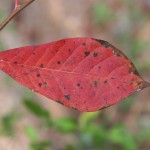Black-Gum, Blackgum, Tupelo
Nyssa sylvatica Marshall
Cornaceae
Description
Blackgum, also named Black Tupelo, is a medium to large-sized tree growing up to 100 ft or 30.5 m in height. The bark is brown to black or gray and is deeply furrowed and broken into small irregular blocks. The simple leaves are alternate, deciduous, and oval to ovate in shape. The leaves are 5 to 15 cm long and 3 to 8 cm wide. The leaves are lustrous green above and paler but pubescent below. The dioecious flowers are greenish and occur in axillary clusters. The male and female flowers occur on separate trees. The male flowers appear in spherical clusters, and the female flowers appear as one or several on a long stalk coming from the leaf axil. Bloom time occurs from April to June. The fruit is a bluish-black drupe and has a solitary light-brown seed. The fruits are eaten by squirrels and several species of birds. Nectar may be used by bee species.Habitat
Blackgum can be found growing in swamps, lowlands, depressions, coastal plains, and open sandy woodlands. Its distribution ranges from Maine down to Florida, westward to Missouri, and south to Texas. It can be found in a variety of climates and survive a wide range of temperatures.Images
Plant Characteristics
Flower Color: Green, White
Seed Type: Drupe, Fruit/Berry
Duration: Perennial
Stem Texture: Hairless/Smooth
Growth Habit: Shrub (Woody), Tree
Leaf Shape
 : Simple with Pinnate or Parallel Venation
: Simple with Pinnate or Parallel Venation
Season: Warm
Distribution
 : 01 - Pineywoods, 02 - Gulf Prairies and Marshes, 03 - Post Oak Savannah, 04 - Blackland Prairies
: 01 - Pineywoods, 02 - Gulf Prairies and Marshes, 03 - Post Oak Savannah, 04 - Blackland Prairies
Distributions
Distribution refers to the ecological region in Texas that a plant has been found. You can also view a clickable map.
Collection: Brush and Weeds







